This fortnight for the Historical Food Fortnightly it’s Make Do or Do Without. Nowadays most ingredients are available year round, and even the more obscure ones are available online, but for historical cooks the options were much more limited. If tomatoes were out of season, too bad. If you lived in Australia and couldn’t get goose, well then you would use parrot instead. And what if you didn’t have the equipment or ingredients to make bread? Then you get inventive.
Whilst not a problem limited to countries of the New World, see for example my post on soda bread, settlers in colonial countries were particularly vulnerable to this problem. The lack of ovens, problems keeping yeast viable in hot weather and the transient lifestyles of stockmen, trappers etc meant that they had to come up with some creative solutions to meet their cravings for bread.
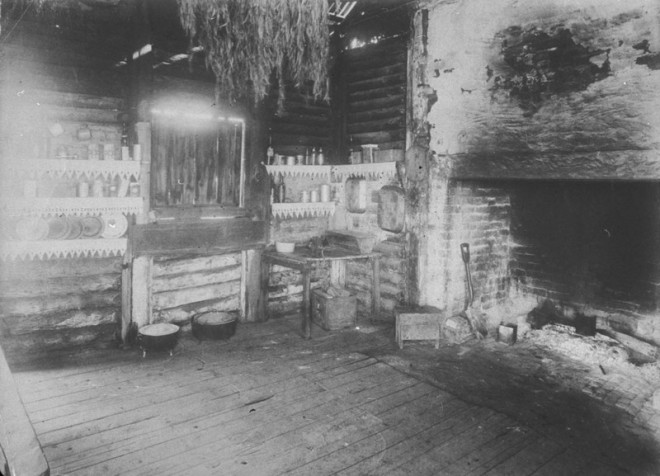
View of a Bush Kitchen, c. 1896. Image courtesy of the State Library of NSW. As you can see, conditions were basic, but this kitchen is actually a step up from the temporary bush camps. Under the window you can see the Dutch ovens used for, among other things, baking damper.
In Australia the quintessential answer was damper, a basic bread made from flour, baking powder, salt and water which is then shaped into a round and baked in the ashes, on a hot stone or in a Dutch oven. Francis Lancelott, a mineralogical surveyor, visited Australia in the mid 1800s and described the weekly menu of a shepherd:
You may talk of the dishes of Paris renown,
Or for plenty through London may range,
If variety’s pleasing, oh, leave either town,
And come to the bush for a change.
On Monday we’ve mutton, with damper and tea;
On Tuesday, tea, damper and mutton,
Such dishes I’m certain all men must agree
Are fit for peer, peasant, or glutton.
On Wednesday we’ve damper, with mutton and tea;
On Thursday tea, mutton and damper,
On Friday we’ve mutton, tea, damper while we
With our flocks over hill and dale scamper.
Our Saturday feast may seem rather strange,
‘Tis of damper with tea and fine mutton;
Now surely I’ve shown you that plenty of change
In the bush, is the friendly board put on.
But no, rest assured that another fine treat
Is ready for all men on one day,
For every bushman is sure that he’ll meet
With the whole of the dishes on Sunday.[1]
But although damper is the best known of the quickbreads that Australian settlers made and ate, it is not the only one. One of the downsides of the damper was that, at nearly a foot in diameter and several inches thick, it took up to an hour to cook. For hungry shepherds, that was a long time to wait and so a series of faster options developed. Johnny cakes, small rounds of dough fried in a dry pan, were based on the American corn breads of the same name, whilst puftaloons were a kind of scone cooked in fat. Other variations included fat cakes, normally containing fat but sometimes cooked in fat, and leather-jackets which seem to be nearly identical to the wheat based Johnny cakes.[2]
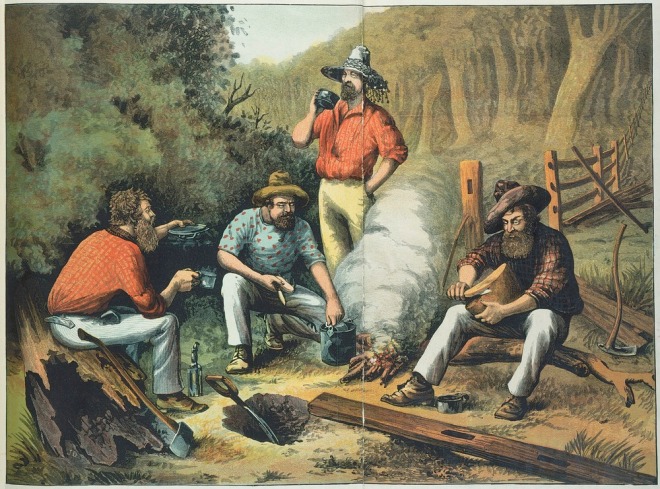
Tea and Damper, 1883, J.D; Troedel & Co. Courtesy of the State Library of Victoria.
I have to admit I was quite intrigued by what I read about puftaloons, also known as puftalooners and puftaloonies. They seemed to be a favourite amongst children and stockmen alike but I’d never heard of them before doing this research. Still, the thought of a scone fried in lard was a bit off-putting.
Would they be soggy, greasy or, even worse, meaty? In fact they were delicious. Soft and scone-like inside but with a harder crust than your average scone. They were perfect for breakfast with some jam but would make an equally nice addition to bacon, eggs and some grilled tomatoes for a lazy brunch or with honey for an afternoon snack. Not only were they very tasty, but they were amazingly fast to make, the whole process took less than 20 minutes. I’m definitely a convert!
The Recipe
The recipe for this comes from a 1904 edition of the Liverpool Herald, an Australian newspaper, but there are dozens of all but identical recipes. A variation for Pineapple Puftaloons is available here (apparently to shred pineapple you use the tines of a fork on a very ripe pineapple, but if anyone has actually done this please let me know if it works!).
The Redaction
1 3/4 cups self-raising flour (I use Australian/UK cup sizes which are slightly different from US sizes)
1 1/2 cups of milk
A pinch of salt
Lard for frying (about 40g)
- Mix the flour and the salt together in a large mixing bowl. Make a well in the middle and pour in the milk. Mix the two together to form a slightly sticky dough.
- Lightly flour a flat surface and turn the dough out onto it. Knead it just until all the ingredients are incorporated. Use a rolling pin to roll it out half an inch thick. Cut out circles using a cutter or the floured mouth of a glass.
- Heat the lard in a frying pan over moderate heat until it’s melted and warm. Add the puftaloons and fry until golden, then turn them over to cook the other side. Keep the heat moderate because the dough needs time to cook all the way through. When golden on both sides drain them on kitchen towel and serve hot with your favourite spreads.
The Round Up
The Recipe: From the Liverpool Herald (available here)
The Date: 1904
How did you make it? See above.
Time to complete?: 20 mins.
How successful was it?: Soft and light inside, with a nice crust. They went well with both sweet and savoury toppings and were still good when reheated.
How accurate?: Pretty good I think, although they were done in a kitchen rather than at a bush camp which would make it significantly more difficult.
[1] Lancelott in Barbara Santich, Bold Palates (Kent Town: Wakefield Press, 2012), 156.
[2] Ibid., 215–220.
Bibliography
“PUFTALOONS.” Liverpool Herald. October 15, 1904.
Santich, Barbara. Bold Palates. Kent Town: Wakefield Press, 2012.
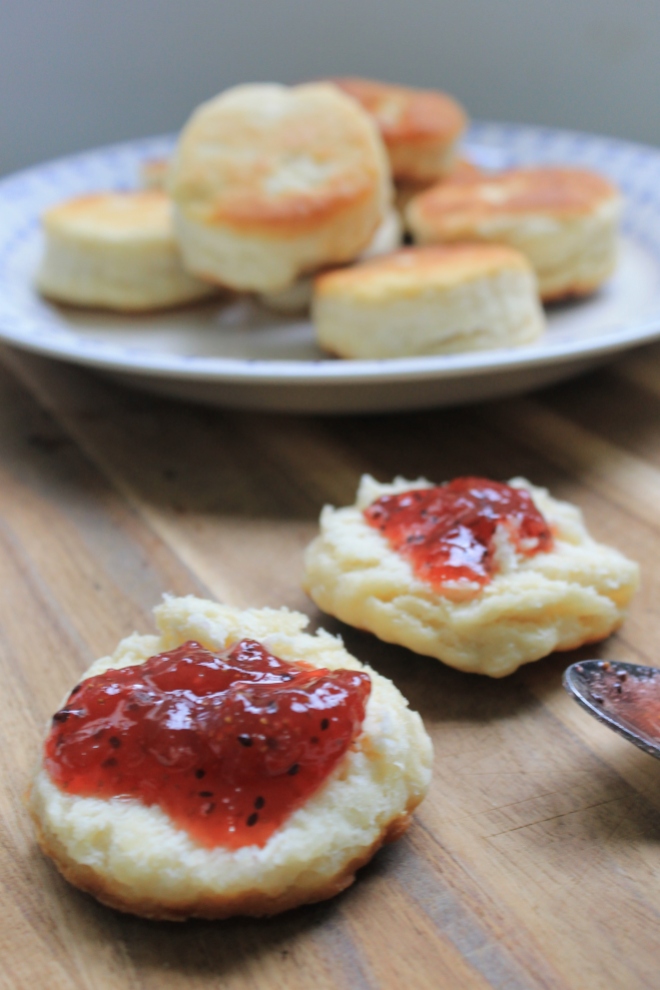
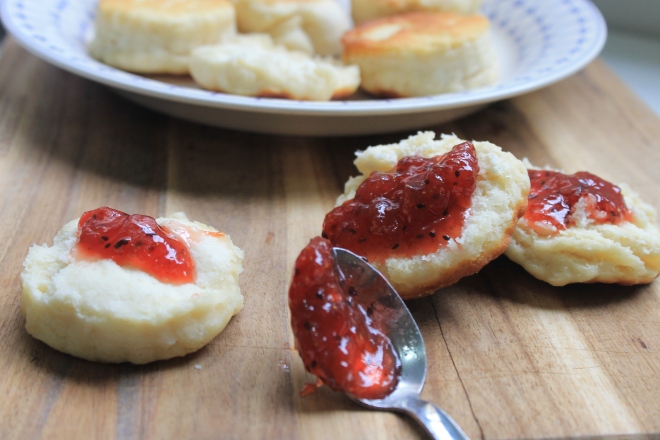
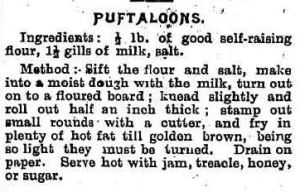
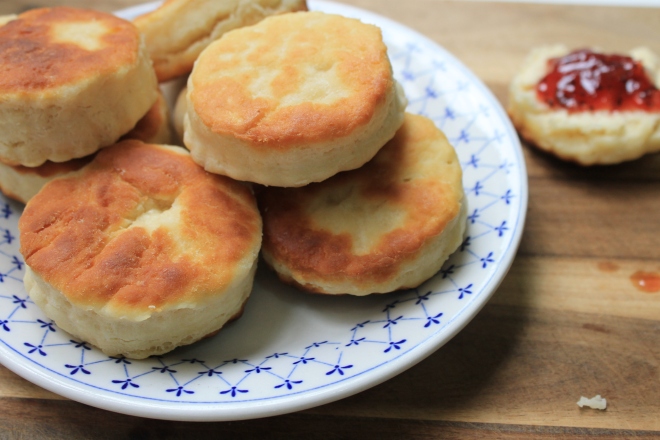
tentimestea says:
Beautiful–they look very tender and light! And it’s certainly gives some perspective to hear about it’s history.
I have to say, I think you’re very courageous to make historical recipes!
April 5, 2015 — 4:21 pm
Daniel Etherington says:
Fascinating. Funnily enough, was just looking at a recipe from baker Justin Gellatly’s book for something he calls pikelets – apparently in the English West Midlands, that name referred to something that looked more like these puftaloons (though yeasted not chemically leavened). I always thought of pikelet as a type of small pancake, after learning to make them in NZ, though what you’d call a pikelet in Australia or NZ we’d probably call a drop scone or Scotch pancake in Britain. Love these food family trees, and how the names vary from place to place.
April 10, 2015 — 4:27 pm
adinah1291 says:
My grandma used to cook them as a treat for breakfast! She used her normal scone dough (which involved naturally soured, ie slightly off, milk as the acid for the baking soda) and deep fried it in the pan full of fat everything got deep fried in, and which used to fascinate me as it cooled and congealed, when I was little. She called them pufftaleens, but I never saw them as anything other than puftaloons in recipe books, including her own.
They were yummy as anything, broken in half and slathered in butter.
April 14, 2015 — 9:42 am
DOREEN MELLOR says:
Golden syrup with butter on puftaloons is absolutely essential!! Absolute favourite ‘treat’ breakfast for kids in Qld in the 1950s
April 26, 2020 — 4:01 pm
Brett Williams says:
My Mum made them every week. We grew up in Queensland in the early seventies and had them with butter and syrup. Wonderful to read about the history as they hold great nostalgia for happy times with my family, my Mum in the kitchen lovingly preparing them for us.
July 6, 2022 — 4:44 am